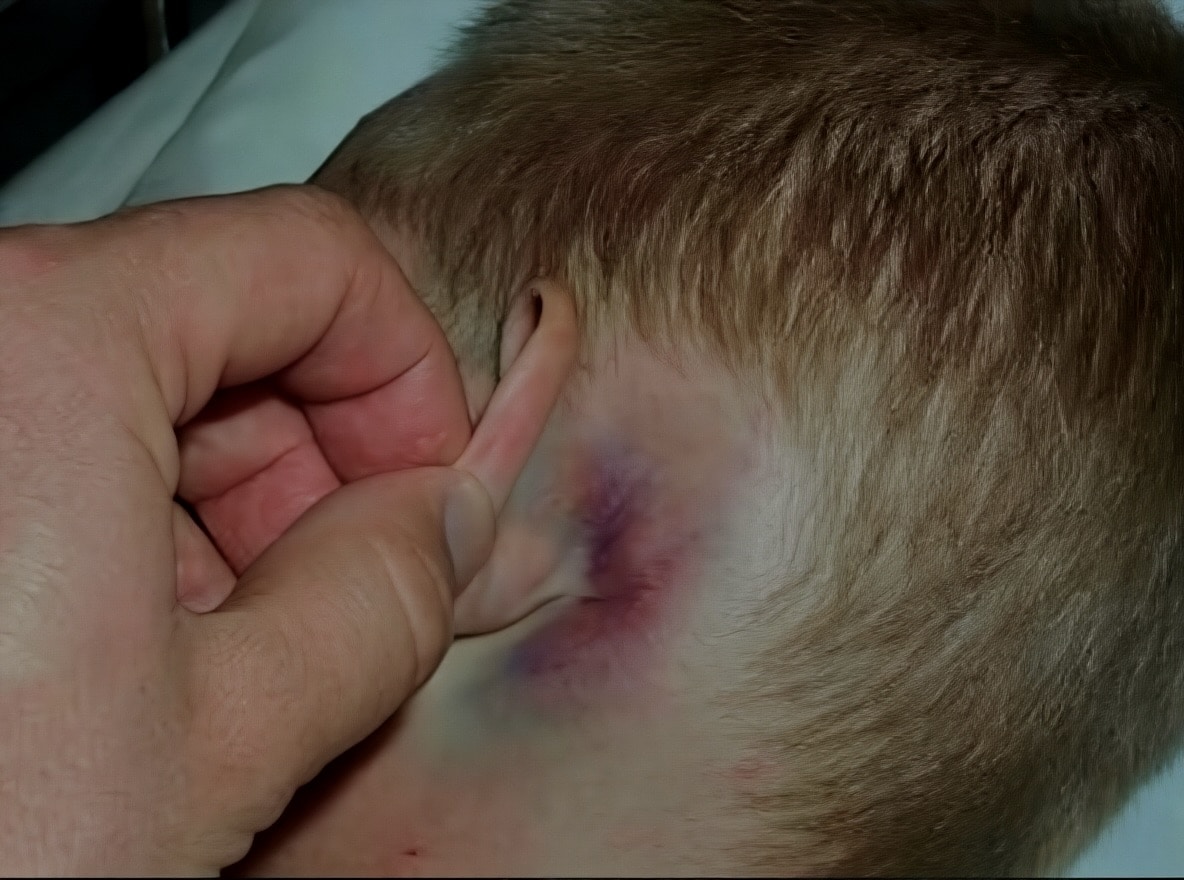Battle Sign
Battle sign refers to postauricular ecchymosis — bruising over the mastoid process — typically indicative of a basilar skull fracture, particularly involving the posterior cranial fossa. It is a critical clinical finding in trauma assessment and a hallmark sign of serious head injury.

The sign results from bleeding through disrupted emissary veins tracking from the sigmoid sinus into postauricular soft tissues following blunt trauma to the temporal or occipital bone. The underlying fracture is most commonly longitudinal or mixed temporal bone fractures. Associated signs may include haemotympanum, external auditory canal laceration, facial nerve injury, and vertigo.
Originally described by William Henry Battle (1855–1936) in 1890, it was anatomically confirmed via cadaveric injection studies. Battle emphasized that the sign may be subtle or concealed by the ear itself.
Modern studies report a positive predictive value >75% for basilar skull fracture, and some suggest that when present, Battle sign correlates with slower neurological recovery. However, the sign is not pathognomonic; rare non-traumatic causes (e.g. hepatic encephalopathy) have been reported.
History of Battle Sign
1861 – Sir Prescott Hewett (1812–1891), surgeon to St. George’s Hospital publishes his observation in A System of Surgery:
Extravasation of blood, and consequent discoloration of the skin, appearing in the mastoid region some hours after a severe injury of the head, may lead to the suspicion of a fracture involving the posterior part of the base ; and all the more valuable will this sign will become, if the injury did not bear directly upon this region, and especially if it bore upon the opposite side of the head.
1890 – William Henry Battle (1855–1936) delivers three Hunterian Lectures at the Royal College of Surgeons and later published as Lectures on some points relating to injuries to the head in the Lancet. He systematically describes mastoid ecchymosis in 17 patients and supports his findings through cadaveric injections and anatomical analysis.
He deemed a postauricular ecchymosis to be “a most important indication that the posterior fossa of the skull is the seat of the fracture” and acknowledged the work and description by Hewett previously.
Observations on this subject lead me to the following conclusions with regard to “mastoid ecchymosis.” That it appears, in the first place, in front of the apex of the mastoid process. That it often spreads upwards over the mastoid in a line, slightly curved, and with the con- vexity backwards, its direction being approximately that of the outline of the external ear, from which it is distant half to three-quarters of an inch.
Battle WH, Lancet July 1890
He also described other cardinal signs including otorhinorrhea, subconjunctival haemorrhage and peri-orbital ecchymoses (racoon eyes).
1890s–1900s – The Battle sign becomes widely cited in trauma texts and clinical practice as a key indicator of skull base fracture.
1936 – Battle dies. His contributions to trauma surgery and clinical signs, including Battle sign, are honoured posthumously by colleagues and journals.
2000s – Diagnostic utility studied; PPV >75% for basilar skull fracture. Clinical guidelines recommend urgent imaging if present.
2008 – Rare non-traumatic presentation reported in hepatic encephalopathy.
Associated Persons
- Sir Prescott Hewett (1812–1891) – Earlier observer of mastoid region bruising in skull base trauma.
- William Henry Battle (1855–1936) – English surgeon; described and popularized the clinical significance of mastoid ecchymosis.
Alternative names
- Mastoid ecchymosis
References
Original articles
- Hewett P. Injuries of the head In: A system of surgery (Edited by Timothy Holmes) 1861; 2: 129
- Battle WH. Lectures on some points relating to injuries to the head. Lancet 1890; 136(3489): 57–63
- Battle WH. Three Lectures on Some Points Relating to Injuries to the Head. Br Med J. 1890; 2(1540): 4-10
Review articles
- Alter M, Steigler P, Harshe M. Mastoid ecchymosis. Battle’s sign of basal skull fracture. Minn Med. 1974 Apr;57(4):263-5.
- Pretto Flores L, De Almeida CS, Casulari LA. Positive predictive values of selected clinical signs associated with skull base fractures. J Neurosurg Sci. 2000 Jun;44(2):77-82; discussion 82-3.
- Rao A. William Henry Battle (1855-1936): Battle’s Sign: Bruising Over the Mastoid Process in Fracture of the Base of the Skull. Trauma. 2002;4(2):125-126.
- Ackland GL, O’Beirne J, Platts AR, Ward SC. False-positive presentation of Battle’s sign during hepatic encephalopathy. Neurocrit Care. 2008;9(2):253-5.
- Tubbs RS, Shoja MM, Loukas M, Oakes WJ, Cohen-Gadol A. William Henry Battle and Battle’s sign: mastoid ecchymosis as an indicator of basilar skull fracture. J Neurosurg. 2010 Jan;112(1):186-8
- Epperla N, Mazza JJ, Yale SH. A Review of Clinical Signs Related to Ecchymosis. WMJ. 2015; 114(2): 61-5.
eponymictionary
the names behind the name
BA MA (Oxon) MBChB (Edin) FACEM FFSEM. Emergency physician, Sir Charles Gairdner Hospital. Passion for rugby; medical history; medical education; and asynchronous learning #FOAMed evangelist. Co-founder and CTO of Life in the Fast lane | On Call: Principles and Protocol 4e| Eponyms | Books |
